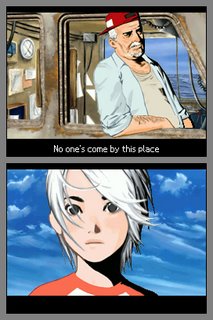VG REVIEW: DS Roundup

“TRAUMA CENTER: UNDER THE KNIFE”
Atlus, for Nintendo DS
rated T for Teen (blood, mild language, mild violence, partial nudity)
$29.99.
“PHOENIX WRIGHT, ACE ATTORNEY”
Capcom
for Nintendo DS
rated T (blood, language, suggestive themes, violence)
$29.99
“TRACE MEMORY”
Nintendo
for Nintendo DS, rated T (mild violence)
$29.99.
“LOST IN BLUE”
Konami, for Nintendo DS
rated E10+ for ages 10 and up. (mild violence)
$29.99
Like a snowball rolling down a hill, Nintendo’s dual screen handheld is racking up quite a number of interesting and entertaining games after a quiet initial release.
We’ve already seen compelling titles like “Nintendogs” and “Meteos” so far this year. Now that the holiday season is ramping up, several more intriguing games have appeared, suggesting that the DS’ unique abilities have encouraged developers to think beyond the pale.
Consider, for instance, “Trauma Center: Under the Knife.” This challenging title lets you play doctor, with your DS stylus serving as scalpel, forceps, syringe and just about any other medical implement you can think of.
The game follows a basic formula: Find out what’s wrong with the patient and fix it before the clock runs out or the patient’s stats drop.
That’s trickier than it sounds, as you’ll have to do a lot of multitasking in order to keep things from ending up like your average episode of “ER.” Thankfully, the nurses will be on hand frequently to give suggestions or outright information on how to get the job done.
The game doesn’t mirror medical science too closely — at one point you develop the ability to slow down time by drawing a star across the bottom screen — but it is one of the best utilizations of the DS’ touch-screen capabilities I’ve seen, not to mention an addictive game in its own right.
From the operating table we move to the courtroom with “Phoenix Wright: Ace Attorney.” In this mystery/adventure game, you play an up-and-coming defense attorney, assigned to a number of seemingly hopeless cases.
Getting a “not guilty” verdict entails digging up evidence, talking to witnesses and then finding contradictions in their testimony. Part of the game’s fun is the ability to yell “Objection” into the DS’ microphone (though you might not want to do that while on the bus).
“Wright” resembles an actual courtroom case in the same way that, say, an Oliver Stone movie resembles the truth. And the game ultimately doesn’t do as much with the touch screen as “Trauma Center” does. You could easily play this on the Game Boy Advance without much alteration in the basic layout.
But while “Phoenix Wright” may not offer a state-of-the-art experience, it’s winning sense of humor, brainy puzzles and overall charm make this a perfect addition to anyone’s handheld library.

“Trace Memory” is a similarly entertaining adventure game, though on a much smaller scale. The plot involves a young girl named Ashley Robbins. After receiving a cryptic message from her father, whom she hasn’t seen since she was a toddler, she heads off to a small, mysterious and apparently uninhabited island.
Unable to locate her father or anyone else, Ashley explores the island and uncovers some of the mysteries surrounding it and her relationship with her dad.
The game follows a structure that will be familiar to anyone who’s played “Myst” or a similar story-based game where solving puzzles and discovering clues is the key to success.
The problem with “Trace” isn’t the game play or the story, both of which are good. The problem is that “Trace” is an incredibly easy game to get through. Most of the puzzles have blindingly obvious solutions, and many gamers will be able to complete the thing within a day or two.
With that in mind, “Trace Memory” might be ideal for the age 10-18 crowd, though the murder mystery surrounding the basic plot would ward off anyone younger.
Finally, we come to “Lost In Blue,” a title that alternates between intriguing and maddening depending upon how far you are into the game.
An interactive “Robinson Crusoe,” “Lost in Blue” washes you up on a desert island, your only companion a young woman who can do little to help you because her glasses are broken and she can’t see without them.
It’s up to you, therefore, to forage for food, make tools, explore the island and numerous other tasks to keep you and your friend alive.
The developers have some great ideas to mix things up (you blow directly into the DS’ microphone in order to start a fire for example). The problem is that you spend so much time looking for food and water that you never get to do anything else. My character was constantly reminding me of how hungry and thirsty he and his companion were, despite my best efforts to stuff all manner of food down their gullets.
In the end, their constant whining got on my nerves and I turned my DS off in disgust. Which just goes to show that innovative game play isn’t enough if you’re going to frustrate the gamer at every turn. “Phoenix Wright” might not have you scraping the touch screen for clam shells, but it’s a lot more entertaining.
 Copyright The Patriot-News, 2005
Copyright The Patriot-News, 2005

0 Comments:
Post a Comment
<< Home